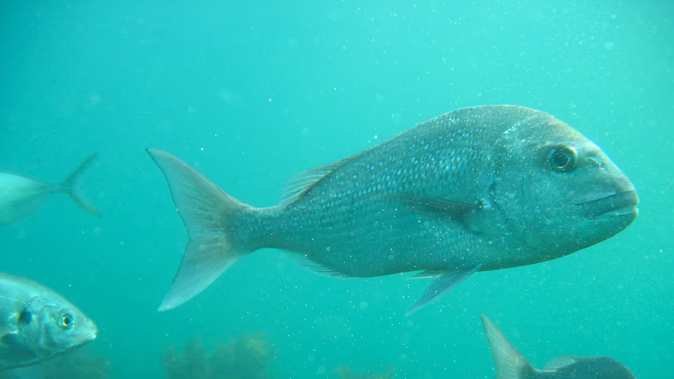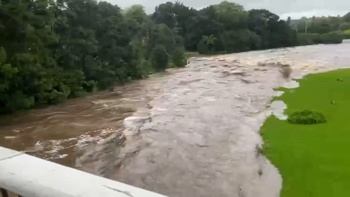
Kaipara Harbour snapper found with higher levels of aluminium than normal do not pose a safety risk as long as they look healthy, according to New Zealand Food Safety.
But Dargaville Ratepayers and Residents Association continues to be concerned about the environmental impact of the high aluminium.
Alarmingly high levels of aluminium were first found in the Northern Wairoa River in Dargaville in June, thanks to voluntary tests done by Grant Hoey from Cannalytic Profiling.
He decided to test the water after the river produced “zombie snapper” – fish so sick they were described as like the living dead.
The Ministry for Primary Industries continues to investigate sick snapper, which have now been found around the North Island.
Separately, Northland Regional Council is continuing to investigate aluminium in the Northern Wairoa, with its tests in late July finding levels of aluminium up to 165 times higher than recommended.
Tests of the flesh of snapper caught in the Kaipara Harbour in June found aluminium concentrations of less than 0.5mg/kg to 2.4mg/kg. This is more than a 2022 survey of snapper from around New Zealand, which found aluminium concentrations of less than 0.3mg/kg to 1.6mg/kg.
New Zealand Food Safety deputy director-general Vincent Arbuckle said the results are similar and the food safety risk from aluminium in Kaipara Harbour snapper is estimated as low.
Using the highest aluminium concentration detected, a 23kg child would have to eat more than 2.73kg of snapper a day, for a prolonged period of time, to exceed the World Health Organization guidelines, he said.
“We consider this consumption unlikely even in communities where fin-fish is the predominant protein source.”
The guidelines aim to protect against potential toxicity, which can damage the reproductive system and developing nervous system.
However, NZ Food Safety continues to advise people to not eat any animal caught or hunted that looks unhealthy – including fish showing the “zombie” symptoms, he said.

The diseased "zombie" snapper have sunken, milky eyes, bones sticking out and a lack of mucus on their skin.
Fishers describe the symptoms as clouded eyes, sunken faces, missing mucus layer or missing flesh, and lethargy.
MPI tests of sick snapper have not identified any food safety concerns associated with common food-borne pathogens and contaminants, nor any exotic or emerging diseases.
“We continue to test samples of the affected fish to determine if naturally occurring biotoxins could be causing the illness,” Arbuckle said.
Historic samples 1000 times guidelines
Meanwhile, Northland Regional Council is continuing to test the Northern Wairoa for aluminium to help narrow down the potential source, as well as liaising with other councils and authorities.
One of its tests east of Dargaville, near the confluence with Awakino River, showed aluminium concentrations of 9.1mg/litre – 165 times the Australia and New Zealand Environment and Conservation Council guideline of 0.055mg/litre for the health of aquatic plants and animals.
Colin Dall, group manager regulatory services, said because limited aluminium testing has been done, it’s too early to say what the “normal levels” of aluminium in the river are but he thought the source could be natural.
Dargaville spokeswoman Rose Dixon is concerned about the health of the Northern Wairoa River, pictured behind her. Photo / Denise Piper
“The council is aware that some soils in the catchment of the river contain naturally high levels of aluminium, which may explain the high concentrations of total aluminium found in water samples.”
But Dargaville Ratepayers and Residents Association chairwoman Rose Dixon said her group is concerned about the river’s health, from the high aluminium and other pollutants.
“We shouldn’t be just worried about ourselves [from the health affects of eating fish] but the environment and the health of our ecosystem.”
The association is worried the high aluminium levels could be coming through Kaipara District Council’s Dargaville wastewater treatment plant if Northland Regional Council is not doing enough checks, Dixon said.
In July, Northland Regional Council said it did not routinely test aluminium levels in waterways. It later revealed to the association it did test aluminium in the Northern Wairoa between 2015 and 2020.
The tests were done at the point where Kaipara District Council back-washed its drinking water filtration, after using commonly used chemicals aluminium sulphate or polyaluminium chloride to treat drinking water through a process called coagulation.
The results showed exceedingly high levels at this point – with one test more than 1000 times the guidelines – until Kaipara District Council’s consent was changed and it was required to pipe this back-wash into its wastewater treatment plant.
Dixon said this raises concerns and her association plans to lodge a complaint about the actions of both councils with the auditor-general. The association previously called for a government inquiry into the Northern Wairoa’s health.
But Dall said the recent high aluminium results are not linked to the drinking water treatment because the back-wash is now treated.
Recent testing suggests the Dargaville wastewater treatment plant is not the source of the aluminium, although Northland Regional Council will continue testing to confirm this.
Kaipara District Council also said recent testing shows its wastewater treatment plant is not the source of the high aluminium.
“These tests have shown the high levels in other parts of the river are not in or near the wastewater treatment plant. Our weekly test results of the wastewater treatment pond are showing levels of aluminium well below the maximum accepted value,” a spokesperson said.
Denise Piper is a news reporter for the Northern Advocate, focusing on health and business. She has more than 20 years in journalism and is passionate about covering stories that make a difference.
Take your Radio, Podcasts and Music with you









